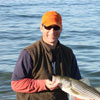License Sales: Where Does the Revenue Go?
By Tom Keer
Nov 06, 2014
Sometimes, I flinch when I buy things. Insurance, that necessary evil, is one that I pay for every month but never seem to use. Gasoline for my truck; seems like every time I turn around I need to pump some more. I wonder about some of the expenses, but I never second guess buying my fishing license.
Sometimes, I flinch when I buy things. Insurance, that necessary evil, is one that I pay for every month but never seem to use. Gasoline for my truck; seems like every time I turn around I need to pump some more. I wonder about some of the expenses, but I never second guess buying my fishing license.
Funding for fish stockings in streams, rivers, ponds, and lakes come from license sales. To a large extent they’re based on economies of scale in that the more fishing licenses that are sold the more fish get stocked. Sometimes the stockings are spread out to more waters while other times a state will offer both a spring and a fall stocking. The more anglers the more fish, and that’s a good thing all around.
My wife Angela and I encountered a few folks from the fish and game department the other day and asked them about their upcoming schedules. Now that their fall fish stockings were completed they began preparing for spring stockings. They reviewed usage reports of what areas saw a lot of anglers, they reviewed fish mortalities from the summer heat, and they would use this data to tweak and modify the spring stockings.
They also had planned an increase in educational programs for kids. They planned on repeating their introduction to fishing programs for sure, but they planned for courses that would appeal to this year’s graduates. Aquatic education, entomology, fish habitat, and conservation were all part of the mix. One of the folks reported a 42% increase in families fishing during the summer through early fall than during the same time last year. The new classes were designed to continue that trend.
Another project that the team was researching was how to increase the number of fish in the most popular river. Evidently the researchers found some big brook trout in the river but they found no small through mid-sized fish. After closer study they figured that there weren’t enough spawning areas. After run off in the spring they’d fix the issue in time for the fall spawning season.
Fishing license sales are directly connected to the conservation of our aquatic natural resources including fisheries-related projects. And they’re partly responsible for the hiring of good folks who need help from folks like you and me.
Funding for fish stockings in streams, rivers, ponds, and lakes come from license sales. To a large extent they’re based on economies of scale in that the more fishing licenses that are sold the more fish get stocked. Sometimes the stockings are spread out to more waters while other times a state will offer both a spring and a fall stocking. The more anglers the more fish, and that’s a good thing all around.
My wife Angela and I encountered a few folks from the fish and game department the other day and asked them about their upcoming schedules. Now that their fall fish stockings were completed they began preparing for spring stockings. They reviewed usage reports of what areas saw a lot of anglers, they reviewed fish mortalities from the summer heat, and they would use this data to tweak and modify the spring stockings.
They also had planned an increase in educational programs for kids. They planned on repeating their introduction to fishing programs for sure, but they planned for courses that would appeal to this year’s graduates. Aquatic education, entomology, fish habitat, and conservation were all part of the mix. One of the folks reported a 42% increase in families fishing during the summer through early fall than during the same time last year. The new classes were designed to continue that trend.
Another project that the team was researching was how to increase the number of fish in the most popular river. Evidently the researchers found some big brook trout in the river but they found no small through mid-sized fish. After closer study they figured that there weren’t enough spawning areas. After run off in the spring they’d fix the issue in time for the fall spawning season.
Fishing license sales are directly connected to the conservation of our aquatic natural resources including fisheries-related projects. And they’re partly responsible for the hiring of good folks who need help from folks like you and me.
Popular Posts









